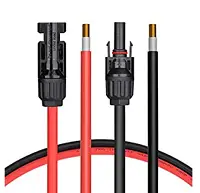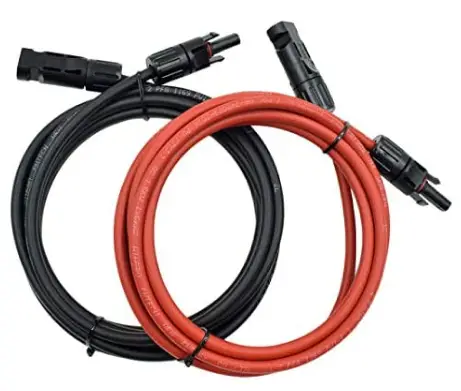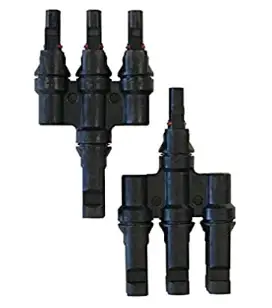As an Amazon Associate, this site earns commissions from qualifying purchases. For more details, click here.
Should you use a copper or aluminum solar wire? What’s the right wire size? What is an MC4 connector for? Solar connectors, wires and cables connect the various components that make up a solar power or PV system. They are the means by which energy is transferred in the system, so knowing how they work is vital. if you’re unfamiliar with the terms, this guide is for you.
The most popular solar wires are copper or aluminum in 8, 12 or 10 AWG sizes. A solar cable consists of two or more wires, with 4mm cables the most commonly used in solar panels. An MC4 connector connects solar panels and other components together.
What is a Solar Wire?

Two or more solar wire makes up a solar cable, and they connect the various parts like the PV modules, batteries, charge controller and inverter. Wires and cables also connect the inverter to the appliances and devices your solar system is powering. There are two types of solar wire, single and stranded.
Single vs. Stranded Wire
A solid or single wire consists of a solitary wire, while a stranded wire is made up of several wires. Single wires are available in small sizes and often used in residential wiring applications. They’re also more affordable than stranded wires.
Stranded solar wires consist of multiple twisted wires. They have a larger diameter than single wires and more flexible. Stranded wire is durable and suitable for outdoor use and is recommended for rooftop and RV solar panel installations.
Wire Material Composition and Insulation
Most solar wires are made of copper or aluminum. Copper is more expensive but offers superior conductivity and has greater resistance to heat and flexibility. Copper wires can also handle more current than aluminum of the same size. Aluminum wires are available in larger sizes, but they’re not as durable. If you’re going to use aluminum wiring, make sure it is durable and designed for outdoor use.
Insulation protects the wires from UV light, heat, water and other substances. Most common solar wire insulation are:
USE-2, PV Wire and RHW-2: ideal for solar panels and other outdoor uses. Provides protection against moisture and UV lights.
TH, THW and THWN: outdoors or indoors. Good for damp environments.
THWN-2: made for the indoors Works with AC and DC circuits and may be coursed through the main service panel. THWN-2 wires are not UV resistant.
Wire Color Guide
Here is the wire color guideline for AC and DC power in the United States. Check your cable wire guide, or contact a licensed electrician if you are uncertain.
| AC Power | DC Power |
|---|---|
| White: grounded conductor | Red: positive |
| Black, Red / Other Color: not grounded | White: grounded or negative |
| Green: grounding for equipment | Green: grounding for equipment |
Wire Rating, Length and Thickness
Your solar panel kit comes with the appropriate wire size which are determined by amp capacity. The more powerful the solar system (i.e. high amp rating), the thicker the cables needed. iI it’s a 12A system, the wire has to be 12A the absolute minimum.
The same rules applies to wire thickness. A 3000W solar system for instance, requires thick cable wires. Wires sizes are measured in AWG, and this chart shows the most common sizes and how many amps they can handle.
| Wire Size | Amp Rating | Typical Applications |
|---|---|---|
| 30 | 200 | Service entrance |
| 1/10 | 150 | Service entrance and feeder |
| 3 | 100 | Service entrance and feeder |
| 6 | 55 | Feeder and large electronics wiring |
| 8 | 40 | Feeder and large electronics wiring |
| 10 | 30 | Air conditioning, appliances |
| 12 | 20 | Circuits for washroom, appliances and bathroom |
| 14 | 15 | Lighting |
Wire length is determined by your setup, amp capacity and acceptable energy loss level (usually 3% to 5%). Of course the primary consideration is the arrangement of your system and the loads it will run. If they are some distance from each other, a long thick cable must be used.
What is a Solar Cable?

A solar cable is made up of several wires. 4mm cables – the preferred choice for solar panels – consists of several wires that work together to move solar power from the panels to the battery, inverter and into the connected devices and appliances. Most 4mm solar cables have 2-5 wires set in a protective cover. There are many types of solar cables, the most popular are DC cable, DC cable main and AC connection cables.
DC Cable: there are two kinds of DC cables, string and modular. Both are compatible with solar panels, and 4mm DC PV cables can be hooked up to an inverter by connecting the negative and positive leads. While 4mm cables are popular, 6mm and 2.5mm cabes are also available. The size of your solar panel determines what cables should be used.
Insulation provides protection for the wires, and they are color coded for easy identification (blue no charge, red positive charge). String cables can be connected to an inverter directly or by way of an AC connection, a DC combiner box or the node string technique. Some solar panels have DC cables built in.
Main DC Cable: these cables join the junction box negative and positive wires to an inverter. 2mm, 4mm and 6mm cables are either single or dual core. Dual core cables are best for generator boxes and / or an inverter. Single core is ideal for various solar panel installations.
AC Connection Cable AC connection cables hook up PV modules with the power grid and safety mechanisms. A 5 core AC connection is designed to work with small PV systems connected to three-phase inverters.
Solar Cable Size Guide
Cable sizing is critical for all solar power systems. If the cable can’t cope with the demand there’s a risk of of overheating, blown fuse or worst case, a fire. No matter what solar power system you are setting up, cable size is of paramount importance.
You can always get a larger, longer cable than needed, but never smaller. There are two factors to consider, the solar panel rating and the distance between the panels and loads. The higher the watt panel capacity, the thicker the cable required. The further the panels and the loads are from each other, the longer and thicker the cable.
As power goes from the panels to the inverter, the cable makes certain energy loss is kept to a minimum. The thicker the cable the better. Other factors to consider are the following.
Protection: the cable must have protection to keep animals from tearing the cover and exposing the wires.
Short circuit resistance: quality solar cables have anti-short circuit features.
Fireproof: look for solar cables that can run at high temperatures without bursting into flames.
Chemical resistant: most cables provide some form of protection against acid and other chemicals.
Durability: the more durable the cable, the better.
Temperature working range: solar cables are designed to work under specific temperature ranges. Find one that can handle extreme levels of cold and heat.
How to Connect a Solar Cable
You’ll need wire strippers, MC4 connectors, an MC4 connector crimping tool and a 4mm cable. MC4 connectors are designed for 4mm cables and even 6mm cables so compatibility is no issue. The cable length will depend on how far the panels are to the other components. This can be a few feet if you’re installing solar panels in an RV or several feet if it’s a house.
- Crimp the male connector.
- Push the cable in the connector until you hear a click. Tighten it.
- Crimp the female connector same way you did with the male.
- Connect the cable. You should hear a clicking sound.
What is an MC4 Connector?

An MC4 connector is the standard means of connecting solar panels. Male and female connectors have safety locks so they won’t just come apart. They are also built for outdoor use and well suited for rooftop solar panels and RVs.
How to Use MC4 Connectors in a Solar Panel Series
Connecting MC4 connectors to a solar panel series is easy. Female connectors are positive and male connectors are negative. Simply connect the positive lead of module 1 to the negative lead of module 2. Repeat for other PV modules you want to add to the series.
Connecting solar panels in a series boost the voltage. if you have two 12V modules, linking them in a series increases the voltage to 24V. Add another 12V module and it becomes 36V. In a series, the current remains the same.
How to Use MC4 Connectors in a Solar Panel Parallel
Parallel solar system configurations require the same leads to be connected. That is, positive to positive and negative to negative. A parallel system keeps the voltage level uniform but increases the amps.
So if you have a couple of 6A modules and and a 36V system, the voltage will remain at 36 while the amps increases to 12. You have to use a multibranch MC4 connector to link the male connectors. You’ll also use this to join the female connectors. A combiner box is required to connect more than two solar panels in parallel.
Frequently Asked Questions
What Cable Size is Used in Solar Panels?
4mm and sometimes 6mm are used in most solar power systems.
What Wire Size Do You Use in Solar Panels?
Solar panels 50W and above often use 10 gauge AWG, which allows 30A current to move from a single PV module.
Can You Use Other Wires Other Than Solar Wires on a PV Module System?
As long as the voltage drop is less than 5%, you can use any wire. Preferably though you should only use wiring designed for solar panels.
Should I Connect Solar Wires in Series or Parallel?
Parallel connections boosts the amps but maintains the voltage. It is ideal for solar arrays with PWM charge controllers and small solar systems. A parallel setup in a 12V system lets you use that voltage consistently. The disadvantage is you need to use thick cables for 1000W+ panels. You also need a combiner box and more MC4 branch connectors.
A series configuration maintains the amperage but increases the voltage. This requires MPPT charge controllers because PWM can’t handle the higher voltage. Energy transfer is not affected over long distances and you can use thin cables.
The disadvantage is if one panel gets shaded, the entire array is affected. This won’t happen in a parallel system because the panels are more independent. So it really depends on what system you’re going to use.
Are MC4 Connectors Necessary?
Yes. Virtually all solar panel systems today use MC4 connectors. That’s why these are included in solar panel kits and other PV modules.
Which MC4 Connector is Positive?
The MC4 male connector connects to the positive + wire lead. The MC4 female connector connects to the negative – wire lead.
Can MC4 Connectors Get Wet?
MC4 connectors are dust proof and waterproof.
What is the Difference between MC3 and MC4 Connectors?
The MC3 is an obsolete connector and no longer used. It has been supplanted by the MC4 as it is more efficient and safer to use. MC3 connectors could come off while PV modules produce power, which is risky.
How Can I Disconnect MCR Connectors?
You need an MC4 disconnect tool, which is designed specifically for this task.
Conclusion
All of these sound more complicated than they really are. Solar panel kits bundle all the connectors, wires and cables you need, so it’s just a matter of putting everything together. You can purchase each piece separately, and they’re widely available online. The small amount of time you spend learning about solar wires, cables and connectors will improve your knowledge greatly.

I am an advocate of solar power. Through portablesolarexpert.com I want to share with all of you what I have learned and cotinue to learn about renewable energy.

